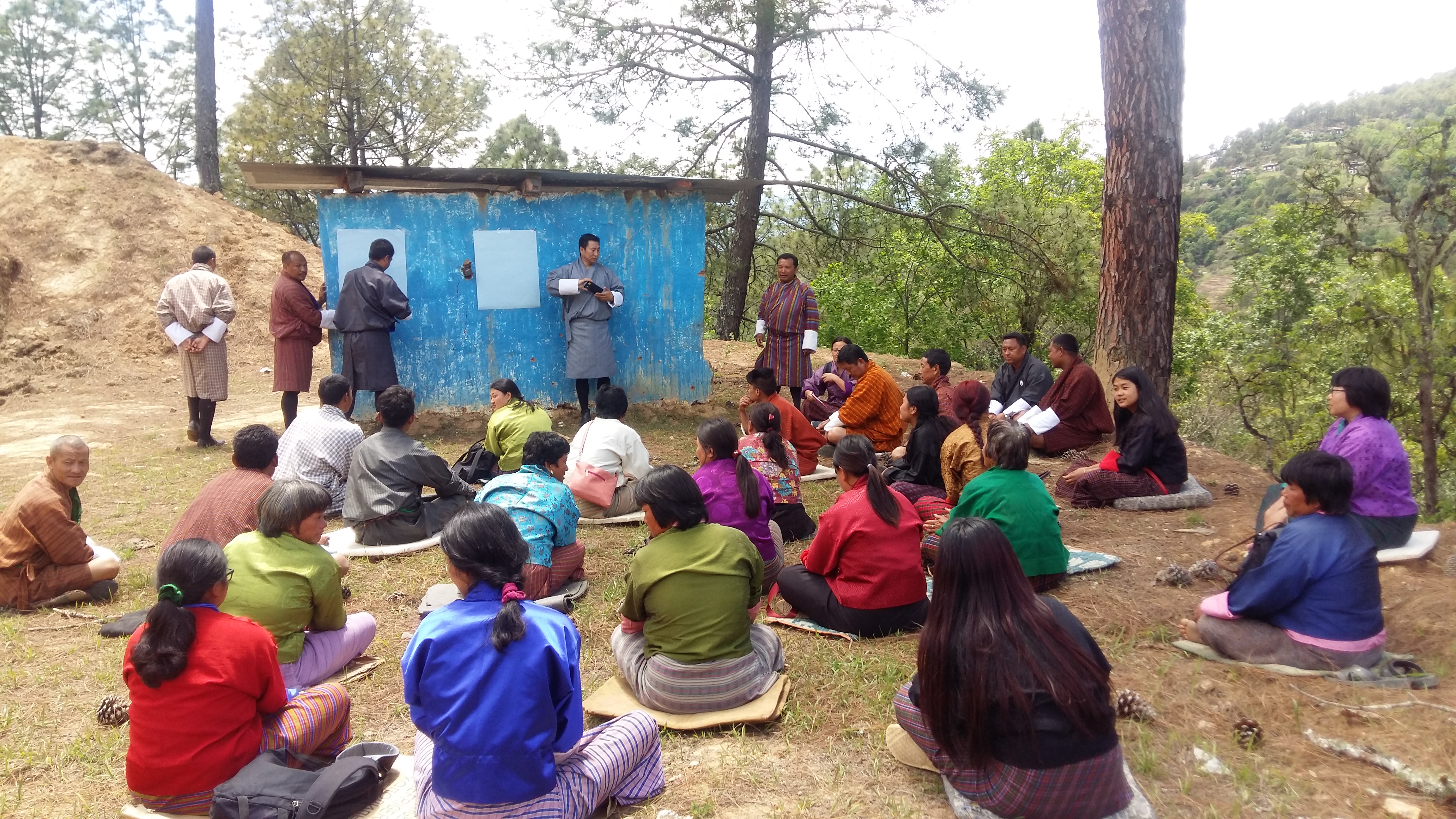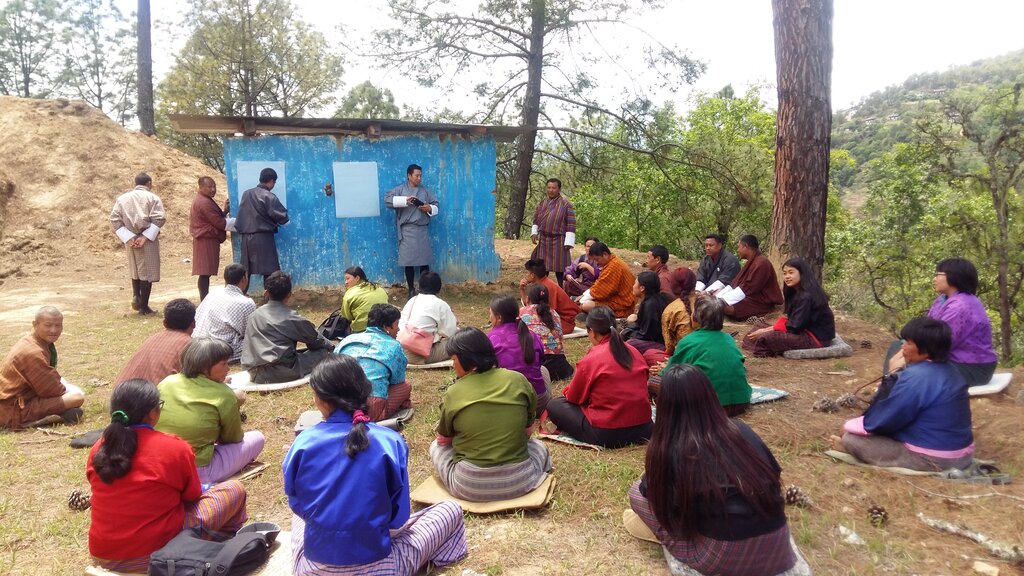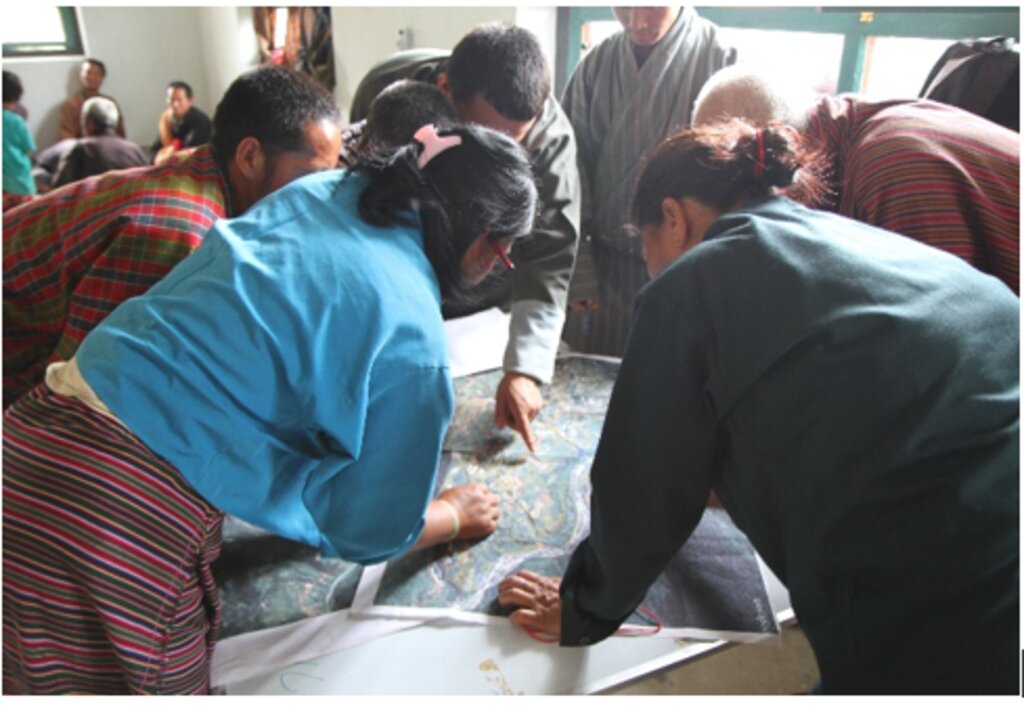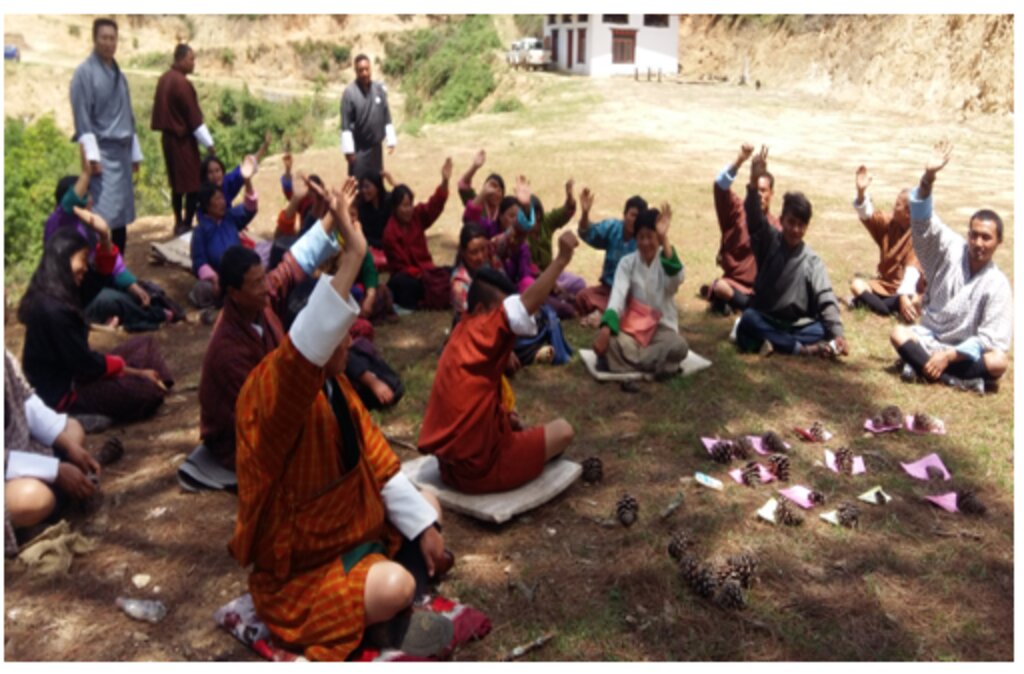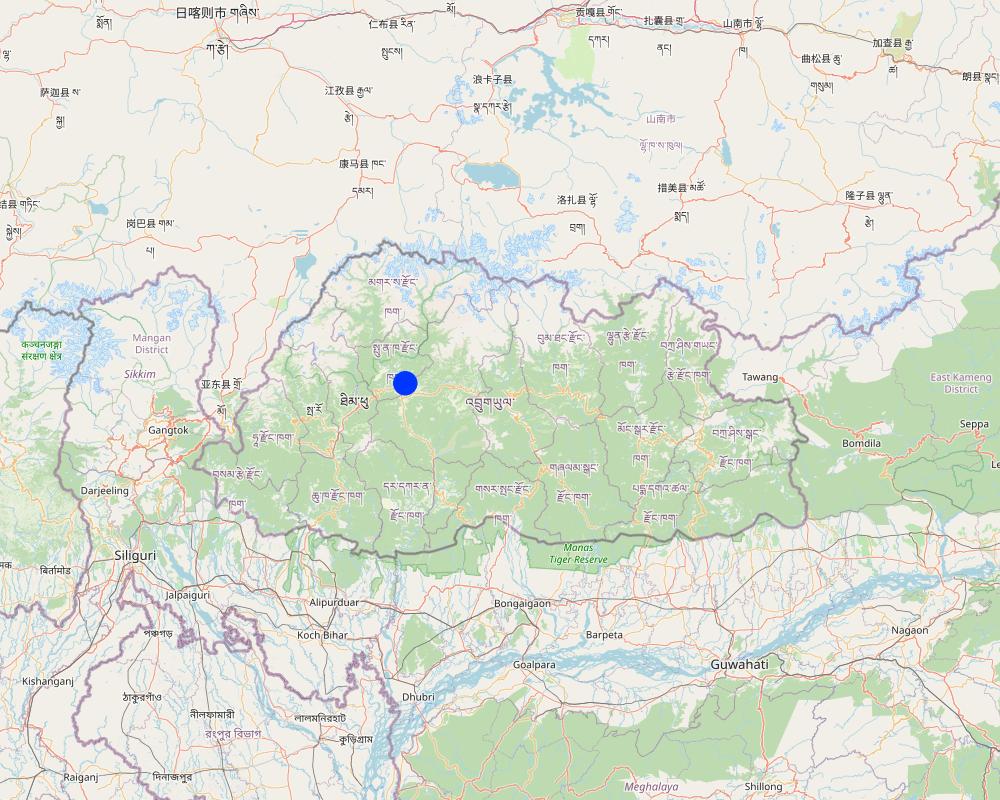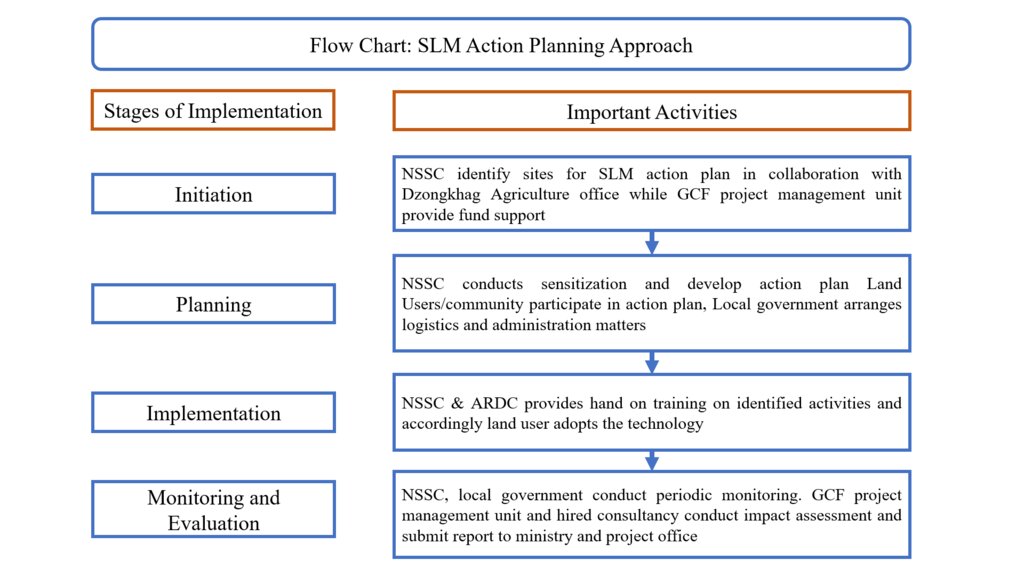Participatory SLM Action Planning [Бутан]
- Создание:
- Обновить:
- Составитель: Karma Wangdi
- Редактор: Haka Drukpa
- Рецензенты: William Critchley, Rima Mekdaschi Studer
Yuenten Sazhi Zinchong Gi Chharzhi Zhoni Nang Dreltog (ཡུན་བརྟན་ས་གཞི་འཛིན་སྐྱོང་གི་འཆར་གཞི་བརྩམ་ནི་ནང་གྲལ་གཏོགས།)
approaches_6819 - Бутан
Просмотреть разделы
Развернуть все Свернуть все1. Общая информация
1.2 Контактные данные специалистов и организаций, участвующих в описании и оценке Подхода
Ответственный (-ые) специалист (-ы)
землепользователь:
Drukpa Tashi Dorji
17627797
Nabchey
Nabchey་chiwog, Lingmukha gewog, Punakha Dzongkhag
Бутан
землепользователь:
Jigme Sonam
77638915
Nabchey
Nabchey chiwog, Lingmukha gewog, Punakha Dzongkhag
Бутан
землепользователь:
Dendrup Sonam
77330534
Nabchey
Nabchey chiwog, Lingmukha gewog, Punakha Dzongkhag
Бутан
землепользователь:
Wangmo Namgay
17414473
Nabchey chiwog, Lingmukha Gewog, Punakha Dzongkhag
Nabchey chiwog
землепользователь:
Zangmo Kinga
17787383
Nabchey,
Nabchey chiwog, Lingmukha gewog, Punakha Dzongkhag
Бутан
Название проекта, содействовавшего документированию/оценке Подхода (если применимо)
Strengthening national-level institutional and professional capacities of country Parties towards enhanced UNCCD monitoring and reporting – GEF 7 EA Umbrella II (GEF 7 UNCCD Enabling Activities_Umbrella II)1.3 Условия, регламентирующие использование собранных ВОКАТ данных
Когда были собраны данные (на местах)?
07/07/2023
Составитель и ответственный/-ые специалист(-ы) согласны с условиями, регламентирующими использование собранных ВОКАТ данных:
Да
2. Описание Подхода УЗП
2.1 Краткое описание Подхода
Participatory SLM action planning is an approach that identifies community-based and land-based issues and challenges, establishes the root causes, and finds out mitigation measures to address the issues for enhancing rural livelihoods.
2.2 Подробное описание Подхода
Подробное описание Подхода:
Participatory SLM Action Planning (SLM AP) is a methodology intended to assess potential SLM interventions in order to address the most severe problems of land degradation. Priorities are determined by identifying the main local issues and their root causes, as well as land-based livelihoods and resources. All community households are included in SLM AP, which is conducted at the chiwog (village) levels. It incorporates Participatory Rural Appraisal (PRA) & Participatory Learning Action (PLA) tools such as natural resource mapping, problem censuses, cropping calendars, history lines, prioritization, ranking and ultimately drawing up a realistic SLM action plan. An external resource person facilitates the discussion while the community decides the final action plan. The process is very interactive and focus group discussions are organized specially for facilitating women’s active participation.
Prior to the SLM action planning exercise, sensitization to available SLM technologies is a must. The sensitization program includes pictorial presentations, relevant SLM audio visuals and displaying of SLM posters. After community sensitization on the first day, the actual SLM action planning exercise is conducted the next day. The participants can discuss with their family members and identify which interventions to incorporate in the plan. The stakeholders involved in the planning exercise consists of community members, local leaders, community civil servants and resource persons. The role of the local leader is to identify interventions that benefits the whole community such as community plantations, landslide stabilization along farm roads, community water source protection and a capacity building program for rural livelihood improvements.
Though this is a holistic bottom-up approach, some of the activities may not qualify for endorsement in the final action plan due to a limited budget and high-cost investments with few beneficiaries. The other drawback is that for every action plan, travel of 3 to 4 days is needed in in every chiwog. In general, the SLM action plan consists of individual household plans and a community SLM plan. Therefore, since every household is included and action plans drawn, land users are satisfied with the approach.
2.3 Фотографии, иллюстрирующие Подход
2.5 Страна/ регион/ место, где применялся Подход
Страна:
Бутан
Административная единица (Район/Область):
Bhutan
Более точная привязка места:
Punakha, Nabchey, Lingmukha
Map
×2.6 Даты начала и окончания реализации Подхода
Год начала реализации:
2020
Если год начала реализации Подхода достоверно неизвестен, дайте примерную оценку:
менее 10 лет назад (недавняя)
2.7 Тип Подхода
- в рамках проекта/ программы
2.8 Каковы цели/ задачи Подхода
To assess potential SLM interventions in order to address the most severe problems with land degradation. Priorities are determined by identifying the main local issues and their root causes, as well as land-based livelihoods and resources.
2.9 Условия содействующие применению Технологии/ Технологий в рамках Подхода или затрудняющие его
Социальные/ культурные/ религиозные нормы и ценности
- содействуют
Team building, Cooperation
Наличие/ доступность финансовых ресурсов и услуг
- содействуют
Project support
Сотрудничество/ координация действий
- содействуют
All the stakeholders including from chiwog levels to Dzongkhag levels are involved in this approach
Осведомленность в области УЗП, доступность технической поддержки
- содействуют
They are aware of importance of SLM approaches and any related issues regarding the SLM are reported to gewog extension for further technical assistance.
Объем работ, доступность рабочей силы
- содействуют
Households helping each other during their work.
- затрудняют
Labor shortages from few households
3. Участие и распределение ролей заинтересованных сторон
3.1 Заинтересованные стороны, участвующие в реализации Подхода и их роли
- местные землепользователи/ местные сообщества
land users
Land users participation in SLM action plan and in program implementation
- эксперты по УЗП/ сельскому хозяйству
Department of Agriculture, National Soil Services Center
Provide technical services, facilitation roles, conducting periodic monitoring and progress reporting
- местные власти
RNR extension staffs , Gewog administration staffs & Dzongkhag Agriculture staff
Program coordination, technical services and timely reporting
- государственные власти (отвечающие за планирование или принятие решений)
Project management team
Providing funding support and field monitoring and reporting of project progress
- международные организации
Green climate fund
Provide financial support and impact assessment
Если участвовало несколько заинтересованных сторон, назовите ведущую организацию:
Green climate fund
3.2 Участие местных землепользователей/ местных сообществ на разных стадиях реализации Подхода
| Участие местных землепользователей/ местных сообществ | Перечислите участников и опишите их вовлеченность | |
|---|---|---|
| инициирование/ мотивация | интерактивное | Land users for participation and NSSC for technical support, |
| планирование | интерактивное | Land users, Green climate fund, NSSC, local government |
| выполнение | интерактивное | Land users, Green climate fund, NSSC, local government |
| мониторинг/ оценка | интерактивное | Local government, NSSC, Project Management Unit |
3.3 Схема реализации (если имеется)
3.4 Принятие решений по выбору Технологии/ Технологий УЗП
Укажите, кто принимал решение по выбору применяемой Технологии/ Технологий:
- все участники как часть процесса совместных действий
Поясните:
After the sensitization on SLM technologies by the NSSC, the land users along with local government decides which technology to adopt considering the local conditions.
Поясните на чём было основано принятие решений:
- анализ подробно описанного опыта и знаний по УЗП (принятие решений на основе подтвержденных фактов)
4. Техническая поддержка, повышение компетенций и управление знаниями
4.1 Повышение компетенций/ обучение
Проводилось ли обучение землепользователей/ других заинтересованных лиц?
Да
Укажите, кто проходил обучение:
- землепользователи
- местный персонал/консультанты
Если существенно, укажите гендерный и возрастной состав, статус, этническую принадлежность и т.д.
Both female and male,
Тип обучения:
- опытные участки
Рассматриваемые темы:
The training consists of in house sensitization and practical demonstration in field. The training topics covers wide range including SLM technologies, Climate resilient practices, group formation for water user association and improved livestock management techniques
Комментарии:
Each person from every household was involved in the training including local government officials.
4.2 Консультационные услуги
Есть ли у землепользователей возможность получать консультации?
Да
Укажите, где именно оказываются консультационные услуги:
- на полях землепользователей
- Extension office
Описание/ комментарий:
Technical services were provided in the field as well as in meetings.
4.3 Институциональная (организационная) поддержка
В ходе реализации Подхода были ли организованы новые институциональные структуры или поддержаны уже существующие?
- да, немного
Укажите уровень, на котором структуры были укреплены или вновь созданы:
- местные
Опишите организацию, функции и ответственность, членство и т.д.
Informal labor sharing group were instituted facilitated by gewog extension officers to speed up the implementation of activities especially benefitting whole community such as water user group.
Укажите тип поддержки:
- финансовая
- повышение компетенций/ обучение
- оборудование
Подробнее:
Funds were provided by the project office on annual workplan basis. Technical assistance provided by NSSC/ARDC/Dzongkhag
4.4 Мониторинг и оценка
Являются ли мониторинг и оценка частью Подхода?
Да
Комментарии:
Periodic monitoring was conducted by Project management Unit, NSSC, Dzongkhag while evaluation were carried out by private consultancy firms deputed by GCF project head office
Если да, будет ли данный документ использоваться для мониторинга и оценки?
Да
Комментарии:
The monitoring reports were submitted annually and presented in the workshops for follow ups.
4.5 Научные исследования
Были ли научные исследования частью Подхода?
Нет
5. Финансирование и внешняя материальная поддержка
5.1 Годовой бюджет мероприятий по УЗП в рамках Подхода
Если точный годовой бюжет неизвестен, укажите примерный диапазон затрат:
- 10000-100000
Комментарий (например, основные источники финансирования/ ключевые доноры):
This budget is for Punakha, Nabchey, Lingmukha funded by Green climate fund
5.2 Финансирование и внешняя материальная поддержка, предоставляемая землепользователям
Предоставлялась ли землепользователям финансовая/ материальная поддержка для применения Технологии /Технологий?
Да
Если да, укажите тип(-ы) поддержки, кто ее предоставил и условия предоставления:
Financial support by Green climate fund on SLM technologies 1) Contour stone bunds construction : USD 61.00/per acre 2) Hedgerows: USD 85/acre, 3) Machine terracing: USD 854/acre, 4) Small (1-2 meter wide and depth) Check-dams construction: USD 18/dam .
5.3 Субсидии на отдельные затраты (включая оплату труда)
- оборудование
| Укажите, какие ресурсы были субсидированы | В какой степени | Опишите субсидии подробнее |
|---|---|---|
| техника | профинансированы полностью | Machines for bench terracing |
| инвентарь/ инструменты | профинансированы частично | Cost sharing (80% by Project, 20% by land user) Green house, |
| fuel | профинансированы полностью | fueling of government machines for terracing |
- сельскохозяйственные
| Укажите, какие ресурсы были субсидированы | В какой степени | Опишите субсидии подробнее |
|---|---|---|
| семена | профинансированы полностью | Horticulture seeds and seedlings |
| профинансированы полностью | ||
- строительные материалы
| Укажите, какие ресурсы были субсидированы | В какой степени | Опишите субсидии подробнее |
|---|---|---|
| камень | профинансированы частично | stone check-dams (45% by project and 55% by land users |
- инфраструктура
| Укажите, какие ресурсы были субсидированы | В какой степени | Опишите субсидии подробнее |
|---|---|---|
| working lunch for labor | профинансированы частично | |
Если труд землепользователя был существенным вкладом, укажите, был ли этот вклад:
- в обмен на продукты
Комментарии:
When materials were freely provided by the project, labor were contributed by beneficiaries, For attending training, working lunch and refreshment were provided by the project
5.4 Кредитование
Предоставлялись ли в рамках Подхода кредиты на мероприятия УЗП?
Нет
5.5 Другие методы или инструменты стимулирования
Использовались ли другие методы или инструменты стимулирования для продвижения Технологий УЗП?
Нет
6. Анализ влияния и заключительные положения
6.1 Влияние Подхода
Сумел ли Подход расширить возможности местных землепользователей, повысить участие заинтересованных сторон?
- Нет
- Да, немного
- Да, умеренно
- Да, существенно
The decisions were made by the land users and the approach was well received.
Сумел ли Подход дать возможность принимать решения на основе подтвержденных фактов?
- Нет
- Да, немного
- Да, умеренно
- Да, существенно
Land users were taken for short study visits to successful SLM sites where by decision made was supported by evidence based observation.
Сумел ли Подход помочь землепользователям внедрить и поддерживать технологии УЗП?
- Нет
- Да, немного
- Да, умеренно
- Да, существенно
Yes, they still practice and maintain the SLM technologies implemented in their field, however, since SLM interventions were of long term return investment requiring high labor, the adoption rate still remains moderate.
Сумел ли Подход расширить знания и возможности землепользователей в применении практик УЗП?
- Нет
- Да, немного
- Да, умеренно
- Да, существенно
Land users were trained on various technologies and advantages and some progressive farmers were scaling up at larger scale.
Yes, farmers know the importance of SLM technologies, climate change and build resilience to negative impacts
Farmers were forming informal SLM group and working on the farm in groups on rotational basis.
Сумел ли Подход расширить возможности социально и экономически уязвимых групп?
- Нет
- Да, немного
- Да, умеренно
- Да, существенно
As all the financial needs were fulfilled by GCF,
Сумел ли Подход содействать гендерному равенству и расширить права и возможности женщин и девочек?
- Нет
- Да, немного
- Да, умеренно
- Да, существенно
Women were equally given opportunity to participate in planning and training program.
Сумел ли Подход стимулировать молодежь/ будущее поколение землепользователей заниматься УЗП?
- Нет
- Да, немного
- Да, умеренно
- Да, существенно
Younger generations were facilitated to take up high tech technologies such as hydroponic, mega green house, drip irrigation and even supported with farm machineries power tillers on cost sharing basis.
Сумел ли Подход разрешить правовые проблемы землевладения/ землепользования, препятствующие использованию технологий УЗП?
- Нет
- Да, немного
- Да, умеренно
- Да, существенно
Vulnerable agriculture farm lands were brought under SLM
Сумел ли Подход способствовать улучшению продовольственой безопасности/ качества питания?
- Нет
- Да, немного
- Да, умеренно
- Да, существенно
Since vulnerable farm lands were brought under SLM, farmers were able to use farm machines, adopt new techniques which facilitated in improving food security and better nutritional up take.
Сумел ли Подход улучшить санитарные условия и доступ к водоснабжению?
- Нет
- Да, немного
- Да, умеренно
- Да, существенно
Improved irrigation water supplies to the farm land
Сумел ли Подход улучшить способность землепользователей адаптироваться к изменениям климата и смягчать последствия катастрофических погодных явлений?
- Нет
- Да, немного
- Да, умеренно
- Да, существенно
Since land degradation and Climate change were two side of same coin, the approach had educated the land users on impacts of climate change and accordingly adapt and build resilience.
Сумел ли Подход привести к созданию новых рабочих мест/ к расширению возможностей получения дохода?
- Нет
- Да, немного
- Да, умеренно
- Да, существенно
Few school drop outs were able to start a farm enterprise and were able to generate cash income and employment ( vegetable production)
6.2 Основные причины, побуждающие землепользователей внедрять УЗП
- рост продуктивности
Once vulnerable farm land were brought under SLM, it was easier for land users to crop and maintain.
- рост прибыли (доходности) и рентабельности
The land users who adopted short term return technologies such as plastic mulching, green house were able to generate income from sale of vegetables.
- снижение деградации земель
The adoption of SLM technologies ( terracing, contour bund) have greatly reduced top soil losses which helped in improving soil fertility and conserving soil moisture.
- снижение риска катастрофических погодных явлений
The random plantation of grass and tree seedlings along the new farm road cutting sites, check dams construction in gullies and landslide stabilizations works have greatly reduced the risk of major landslide and gully formation.
- снижение объёма работ
land users workload were drastically reduced through farm mechanization. Even establishment of Napier grass hedgerows have made the work easier for women in collection of fodder for livestock.
- материальное стимулирование/ субсидии
Cost sharing mechanism and subsidies payment by Project had also contributed in adoption of SLM technologies to larger scale.
- причастность к движению/ проекту/ группе/ сети
Project funded all the cost and benefits encouraging people to work in collaboration with government and the project
- экологическая сознательность
Land users were sensitized on negative impacts of environment degradation especially poor management of natural resources and use of excessive fertilizers and chemicals.
- приобретение знаний и опыта в области УЗП
Most of the land users were aware of SLM and its importance.
- улучшение эстетической привлекательности
SLM technologies such as terracing, hedgerows establishment and contour bund had not only reduced surface soil erosion, but had significantly contributed in beautifying the overall landscape. Even plantation in landslide sites and along new road cuttings sites had stabilized with more green vegetations.
6.3 Долгосрочная устойчивость мероприятий в рамках Подхода
Могут ли землепользователи самостоятельно (без внешней поддержки) продолжать применение того, что было реализовано в рамках Подхода?
- да
Если да, опишите как:
Most of the SLM interventions were of one time investment and maintenance cost were very minimum. The land users will be able to take care and incase of major issues, the funds will be supported by the local government for maintenance such as irrigation channel renovation.
6.4 Сильные стороны/ преимущества Подхода
| Сильные стороны/ преимущества/ возможности по мнению землепользователей |
|---|
| The Participatory SLM planning approach is basically putting the farmers first and farmers last. Since the plan is developed by land users, they take full ownership which ensures sustainability of the program. |
| Improved social interaction and cohesion |
| Opportunity for mass sensitization on SLM and climate change to the land users |
| Сильные стороны/ преимущества/ возможности по мнению составителя или других ключевых специалистов |
|---|
| Best approach in empowering rural land users. |
| Experts needed to facilitate only |
| Ensures sustainability and successful program implementation |
6.5 Слабые стороны/ недостатки Подхода и пути их преодоления
| Слабые стороны/ недостатки/ риски по мнению землепользователей | Возможные пути их преодоления/снижения? |
|---|---|
| Expertise and knowledge gap | consult SLM specialist |
| Elite land users dominating the decision making power | Give equal opportunity to all actors in decision making. |
| Poor participation or un-responsive participants during meetings | Meeting to be attended by head of the household or one who can decide and have decision making power. |
| Слабые стороны/ недостатки/ риски по мнению составителя или ответственных специалистов | Возможные пути их преодоления/снижения? |
|---|---|
| Difficult to fulfill all demands enlisted in the action plan ( ambitious plan). Some interventions are outside project scope while its of utmost importance to the community such as farm road construction, human wildlife conflicts and new irrigation channel construction requiring high investment. | Sensitization on Project scope, its intended supports and forward the outside project activities to the local government for sourcing funds. |
| Taking program at chiwog level is time consuming and its resource intensive. | Systematic planning and proper budget from initial phase |
| Some land users takes opportunity of the project support though its not much important to them ( free inputs). | Periodic monitoring to ensure the proper utilization. |
7. Справочные материалы и ссылки
7.1 Методы сбора/источники информации
- выезды на места, полевые обследования
1
- опросы землепользователей
1
- опросы специалистов/экспертов по УЗП
1
7.2 Ссылки на опубликованные материалы
Название, автор, год публикации, ISBN:
NSSC Bhutan catalogue of soil and water conservation approaches and technologies, 2012
Где опубликовано? Стоимость?
National Soil Service Center, Department of Agriculture, Ministry of Agriculture and Livestock, RGOB.
Название, автор, год публикации, ISBN:
Agriculture land development guidelines (17th June 2017)
Где опубликовано? Стоимость?
National Soil Service Center, Department of Agriculture, Ministry of Agriculture and Livestock, RGOB.
7.3 Ссылки на материалы, доступные онлайн
Название/ описание:
Agriculture Land Development Guideline
Адрес в сети Интернет:
www.nssc.gov.bt
Ссылки и модули
Развернуть все Свернуть всеСсылки
Нет ссылок
Модули
Нет модулей


